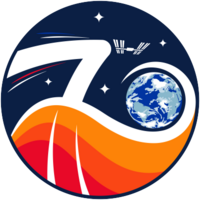Expedition 70
| Expedition 70 | |||
 | |||
| Uppdragsstatistik | |||
|---|---|---|---|
| Rymdstation: | ISS | ||
| Start: | 27 september 2023 | ||
| Slut: | 6 april 2024 | ||
| Tid: | 191 dag, 20 tim | ||
| Rymdpromenad | |||
| Antal rymdpromenader: | 2 st | ||
| Total tid: | 14 tim, 23 min | ||
| Transport | |||
| Uppskjutning: | med | ||
| Uppskjutningsplats: | Kosmodromen i Bajkonur Kennedy Space Center | ||
| Landning: | med | ||
| Landningsplats: | Kazakstan Atlanten | ||
| Kronologi | |||
| |||

Expedition 70 var den 70:e expeditionen till Internationella rymdstationen (ISS). Expeditionen började den 27 september 2023 då delar av Expedition 69s besättning återvände till jorden med Sojuz MS-23.
Matthew Dominick, Michael R. Barratt, Jeanette J. Epps och Alexander Grebenkin kommer ansluta till expeditionen i början av mars 2024
Jasmin Moghbeli, Andreas Mogensen, Satoshi Furukawa och Konstantin Borisov kommer lämna expeditionen under mars månad.
Tracy E. Caldwell anslöt till expeditionen i slutet av mars 2024.
Expeditionen avslutades den 6 april 2024 då Sojuz MS-24 lämnade rymdstationen.
Axiom Mission 3
Mellan den 20 januari och 7 februari 2024 besöktes expeditionen av Michael López-Alegría, Walter Villadei, Alper Gezeravcı och Marcus Wandt.[1]
Besättning
| Position | Första delen (27 september 2023 - 5 mars 2024) | Andra delen (5 mars - 11 mars 2024) | Tredje delen (11 mars - 25 mars 2024) | Fjärde delen (25 mars - 6 april 2024) |
|---|---|---|---|---|
| Befälhavare | Hans andra rymdfärd | Hans femte rymdfärd | ||
| Flygingenjör | Hans första rymdfärd | |||
| Flygingenjör | Hennes första rymdfärd | |||
| Flygingenjör | Hans femte rymdfärd | Hennes tredje rymdfärd | ||
| Flygingenjör | Hennes första rymdfärd | |||
| Flygingenjör | Hans andra rymdfärd | |||
| Flygingenjör | Hans första rymdfärd | |||
| Flygingenjör | Hans första rymdfärd | |||
| Flygingenjör | Hans tredje rymdfärd | |||
| Flygingenjör | Hennes första rymdfärd | |||
| Flygingenjör | Hans första rymdfärd | |||
Externa länkar
Referenser
- ^ ”Four Ax-3 Astronauts Board Station and Meet Expedition 70 Crew” (på engelska). NASA. 20 januari 2024. https://blogs.nasa.gov/spacestation/2024/01/20/four-ax-3-astronauts-board-station-and-meet-expedition-70-crew/. Läst 19 februari 2024.
| |||||||||||||||||||
Media som används på denna webbplats
Mission insignia for International Space Station (ISS) Expedition 70
- The Expedition 70 patch is designed around the central yin-yang symbol representing balance; first and foremost, the balance of our beautiful planet Earth that is encircled by the yin-yang symbol and which forms part of the Expedition number. In our exploration of space, we are reminded of the uniqueness of Earth; the further we push the boundaries of human existence, the stronger our longing for our home planet grows. As our understanding of the cosmos expands, so does our understanding of Earth, and although we live in an ever-changing world, we recognize the need for a planet in balance to ensure our future.
- Space exploration is also about creating the future of our dreams. The tentative first steps we take today will hopefully become a well-trodden path in the future. This is represented stylistically by the “retro-futuristic” design of the patch, which mimics the design of the posters depicting the future from the early days of the space age. It is also emphasized by the yellow, orange, and red colors suggesting a sunrise. Lastly, the dynamism in the depiction of the number 7 suggests not only the physical launch into space, but also humanity’s progress towards the future.
Mission insignia for International Space Station (ISS) Expedition 69.
- The Expedition 69 patch reflects the mission of the International Space Station to enable long-term exploration of space, for the benefit of Earth. The unique mosaic design is inspired by the vintage, Art Deco stained glass window in Star City, Russia that provides a stylistic portrayal of the beauty of space exploration. The number "69" forms a circle to symbolize the international partnerships and collaboration that make the space station program possible. The Earth is the central element inside the "6" as our home planet and the primary beneficiary of research onboard space station. The star shining from Earth, spanning multiple continents, represents the ground teams around the world who support every aspect of this expedition and ensure our safe retum home. The space station itself signifies the contributions of thousands of people over the past several decades, whose vision and sustained efforts have made this miracle of a laboratory an unparalleled success. Looking towards the future, the next big steps in human space exploration are reflected in the Moon and Mars. The sun around Mars is symbolic of the human imagination, curiosity, and ingenuity that draws us to explore, The two white stars in the sky are taken directly from the Star City mural. The larger star represents the family and friends whose love and support makes this endeavor possible. The smaller star represents the explorers who came before us and helped pave the way to the stars.
Mission insignia for International Space Station (ISS) Expedition 71
- For nearly a quarter of a century the International Space Station (ISS) has hosted crews and accommodated science experiments even as it has continued to evolve into the highly capable orbiting laboratory of today. With its unique vantage point, the ISS serves as an intersection for discoveries ranging from the vast, such as the search for dark matter and cosmological origins, to the near, such as detailed observation of our home planet and its atmosphere, to the microscopic, including behavior of microbial life, DNA sequencing, and molecular biology in the microgravity environment.
- The Expedition 71 patch celebrates this science as well as the thousands of multinational scientists and technicians that have contributed to numerous groundbreaking experiments. The ISS is the ultimate destination for the scientifically curious.
- The symbology represents onboard research into quantum behavior of novel states of matter, antibodies and immune function, the search for dark matter, flame and combustion physics, DNA expression, plant growth and root behavior, and direct earth observation. The human eye and microscope objectives at upper left form the apex of a cone of vision culminating in the Expedition number 71, and represents the deliberate and disciplined practice of scientific observation.
- Earth’s moon and Mars are also depicted as next steps for exploration, with an anticipation of further rich scientific discovery using many techniques and skills honed aboard the ISS.
The official Expedition 70 crew portrait with (top row from left) Roscosmos cosmonauts Nikolai Chub, Konstantin Borisov, and Oleg Kononenko; JAXA (Japan Aerospace Exploration Agency) astronaut Satoshi Furukawa; and NASA astronaut Loral O'Hara. In the front row are, ESA (European Space Agency) astronaut and Expedition 70 Commander Andreas Mogensen and NASA astronaut Jasmin Moghbeli.







